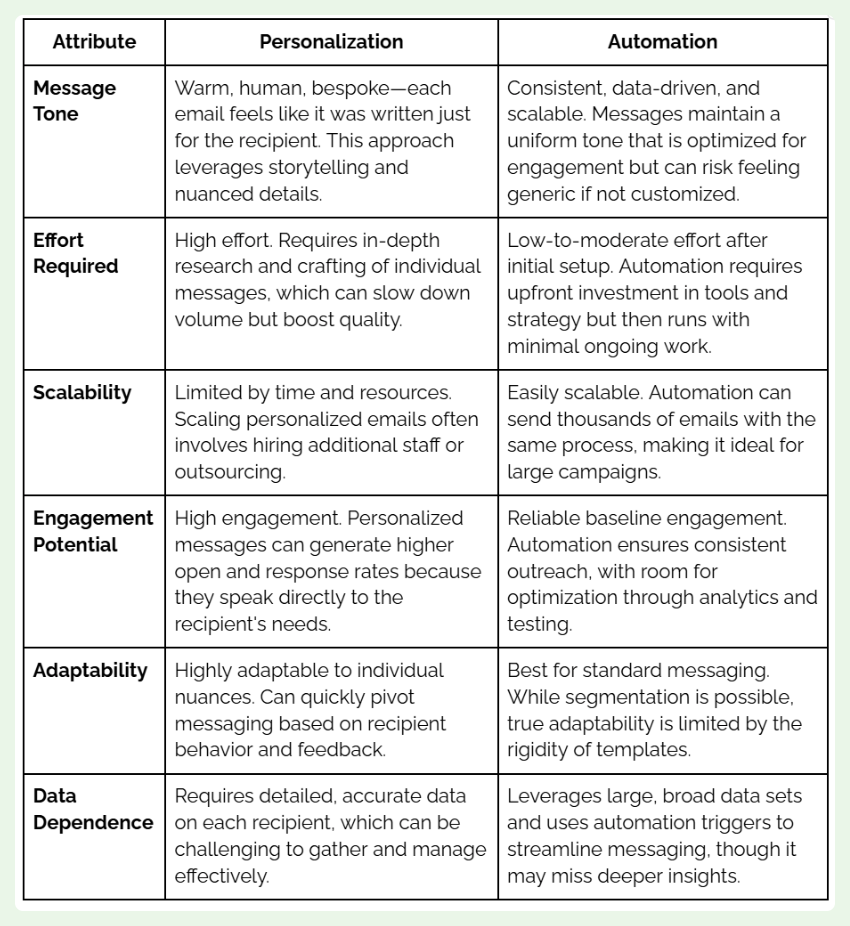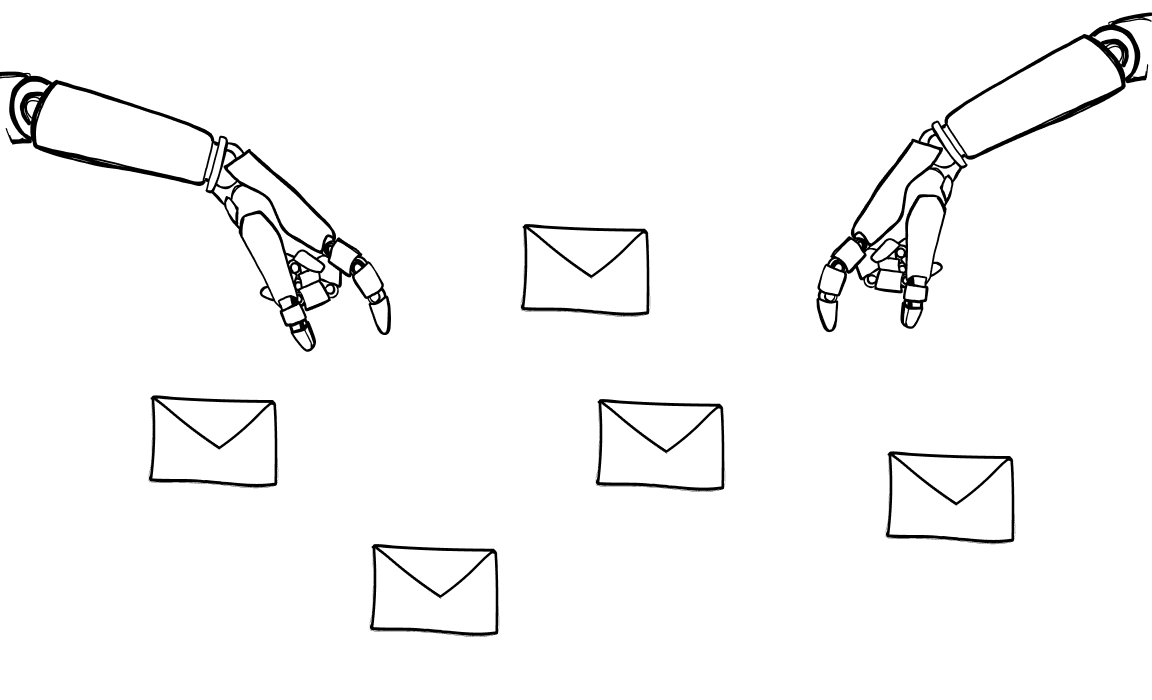In cold emailing, every message is a chance to spark interest, build a relationship, and convert a prospect into a customer.
Marketers often face a strategic dilemma: should they invest the time to craft hyper-personalized emails or lean on the efficiency of automation to reach a larger audience?
The answer isn’t about choosing one over the other—it’s about finding the perfect blend that maximizes your outreach while retaining a human touch.
This battlecard dives deep into the advantages, challenges, and best practices for both personalization and automation in cold emailing, offering actionable insights, real-world examples, and a clear comparison to help you optimize your strategy.
Overview
Personalization involves tailoring every email to speak directly to the recipient by using specific data points—like the recipient’s name, company details, industry trends, or even recent accomplishments.
This approach creates a warm, one-on-one interaction that can resonate deeply with potential customers. However, it often requires significant time and effort, making it challenging to scale.
On the other hand, Automation uses tools and workflows to send large volumes of emails with consistency and efficiency.
Automated campaigns can be set up to run with minimal ongoing input, allowing you to reach a broader audience quickly. Yet, automation can sometimes feel impersonal if it relies too heavily on templates without incorporating dynamic content.
The sweet spot lies in balancing both strategies: using automation to scale your outreach while embedding personalized elements that make each message feel uniquely crafted for the recipient.
Key Attributes: A Comparative Deep Dive

Pros and Cons: The Trade-offs in Detail
Personalization
Pros:
- Enhanced Connection: Tailored emails resonate deeply, creating a sense of personal connection and increasing the likelihood of a response.
- Standout Messaging: In a crowded inbox, a personalized email catches the eye and differentiates your outreach from generic mass emails.
- Higher Quality Engagement: Personalized outreach often results in more thoughtful responses and opens the door to richer conversations, paving the way for better lead qualification.
Cons:
- Resource Intensive: Crafting individual messages is time-consuming and requires significant effort, which may limit the volume of outreach.
- Scalability Challenges: Maintaining high-quality personalization becomes increasingly difficult as your prospect list grows.
- Inconsistency Risk: Manual processes can lead to variation in the quality of emails, resulting in mixed responses from different segments of your audience.
Automation
Pros:
- Efficiency and Scale: Automation allows you to send thousands of emails quickly and consistently, making it ideal for reaching large audiences.
- Consistent Messaging: Automated campaigns ensure that every recipient gets a uniform message, reducing the risk of human error.
- Data-Driven Optimization: Integration with analytics tools enables continuous testing and refinement of your messages for optimal performance.
Cons:
- Generic Outreach Risk: Over-reliance on templates can result in emails that feel impersonal, reducing the chance of a genuine connection.
- Limited Personal Touch: Automation may overlook individual recipient nuances, leading to lower engagement for high-priority leads.
- Initial Setup Complexity: Setting up an effective automation system requires time, technical know-how, and sometimes significant upfront costs.
Best Practices for Achieving the Balance
Blend the Two Strategies
Segmentation and Dynamic Content:
Start by segmenting your audience using key data points such as industry, job role, and past interactions. For high-priority segments, integrate dynamic content blocks into your automated emails. For example, use tools that automatically insert the recipient’s name, recent company news, or personalized product recommendations. This ensures that while your outreach remains automated, it retains a personal touch.
Hybrid Campaigns:
Design campaigns that begin with a standardized, automated drip sequence and then trigger personalized follow-ups based on engagement. For instance, if a recipient clicks a link or responds to the initial email, the system can notify a sales rep to send a custom, tailored message. Using AI meeting notes, teams can streamline follow-ups by referencing key discussion points and action items automatically captured from previous conversations. This strategy not only scales well but also leverages the strengths of both approaches.
Optimize Through Testing
A/B Testing:
Regularly test different elements of your emails—from subject lines and content variations to CTAs. Analyze which personalized elements lead to higher engagement versus those that perform well within automated templates. Testing allows you to fine-tune your balance over time, ensuring your outreach remains both efficient and effective.
Feedback Loops:
Collect feedback directly from your sales team and analyze response data to continuously refine your strategy. Adjust segmentation criteria and personalization tactics based on what the data tells you about what resonates with different segments.
Leverage Advanced Technology
CRM and Automation Platforms:
Integrate your CRM with your email automation tools to centralize data and enable real-time updates. This integration allows you to track interactions across the customer journey and adjust messaging accordingly. Platforms like Outreach, HubSpot, Retainful and Mailchimp offer robust features that support both content automation and personalization. Consider incorporating makerspace software to streamline workflow automation alongside your CRM, enhancing efficiency and collaboration.
Dynamic Personalization Engines:
Consider investing in tools that offer dynamic personalization capabilities. These engines can adjust content on the fly based on individual user behavior and demographic data, ensuring that every email feels uniquely crafted even when sent in bulk. You could also use AI for content personalization.
Referral Automation Platforms:
Referral programs can benefit from a mix of automation and personalization. Tools like ReferralCandy help simplify referral processes while allowing businesses to personalize incentives based on user behavior. With referral automation and CRM data, companies can identify high-potential advocates and tailor outreach to maximize engagement.
Real-World Use Cases
Case Study 1: Boutique SaaS Provider
A boutique SaaS company targeting mid-sized businesses implemented an automated segmentation strategy. They used personalization for the top 10% of prospects by crafting custom emails that referenced recent industry developments and the prospect’s specific challenges. The rest of the list received dynamically generated content based on their company size and industry. This hybrid approach boosted response rates by 40%, with the personalized group showing even higher engagement and conversion rates.
Case Study 2: E-commerce Platform Re-Engagement
An e-commerce mobile app development and platform sought to re-engage dormant users by launching an automated drip campaign that incorporated personalized product recommendations based on past purchase history. Dynamic content blocks inserted the user’s name and personalized discount codes, while high-engagement users received a follow-up email from a dedicated sales rep. This hybrid strategy increased reactivation rates by 25% and led to a significant uptick in overall customer satisfaction.
Case Study 3: B2B Marketing Firm
A B2B marketing firm adopted a fully automated campaign for initial outreach, using detailed segmentation and data-driven triggers to send follow-up emails. However, when a lead showed signs of engagement, the system automatically alerted a sales representative who then sent a custom email addressing the lead’s specific needs. This blend of automation and personalization resulted in shorter sales cycles and higher conversion rates, demonstrating the power of a balanced approach.
Final Thoughts
The battle between personalization and automation in cold emailing isn’t about choosing one over the other—it’s about blending the two to create a seamless, efficient, and human-centric outreach strategy. By combining the scalability and consistency of automation with the nuanced touch of personalization, you can maximize engagement and drive better conversion rates.
This battlecard provides a roadmap for evaluating and refining your cold emailing approach. Use it to assess your current strategy, experiment with dynamic content, and continually optimize your campaigns through testing and data analysis. When done right, you’ll enjoy the best of both worlds: reaching a broad audience efficiently while making each recipient feel uniquely valued.
Happy emailing, and here’s to finding that perfect sweet spot in your outreach efforts!

